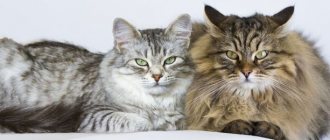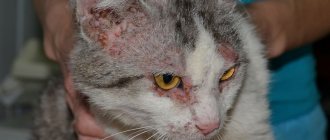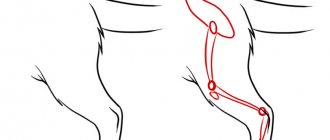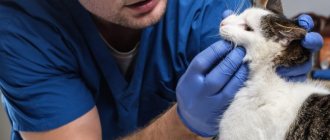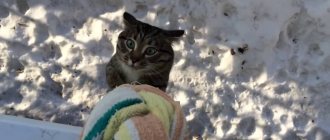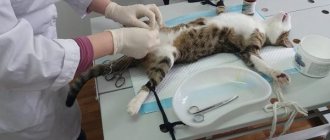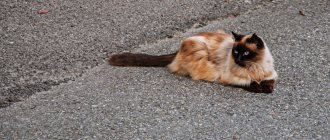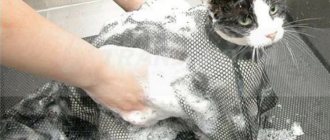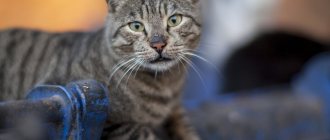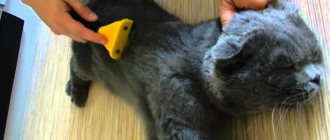Why do cats need mustaches and eyebrows?
Our pets, cats, belong to the cat family. They are all different: fluffy or smooth-haired, but always equally loved. Perhaps someone will say that all cats are the same, but a true connoisseur and true owner knows that they have a different shape of face and ears (after all, a real family member does not have a “muzzle”). Some have a large nose, some have a small, flattened one, but, of course, all cats have long eyebrows and whiskers.
Chic, lush eyebrows and mustaches always added greatness to the cat, and helped the owner determine the mood of his pet. If the whiskers stick out forward and the tips are down, this means that the cat is interested in something. If the whiskers are pressed to the muzzle, the cat is bored and is not at all interested in what is happening around him. Or, on the contrary, the cat is trying to distance itself from what is next to it.
The cat-shaped eyebrows and bushy mustaches act as night radars and detectors. It is thanks to the function of touch through the eyebrows and whiskers that cats move easily in the dark, accurately avoiding all obstacles. When passing objects, the cat uses its whiskers to scan changes in air flow, and even without touching the object, it can determine its size and weight.
The whiskers and eyebrows of cats have a scientific name - vibrissae. However, they grow not only on the head, but also on the beard and on the inside of the paws. When a kitten is in the fetal stage, the whiskers are the first hairs to develop. This is specially predetermined by nature so that the kitten can easily begin to contact the environment. The walls of the hair bags, in which the vibrissae are located, consist of nerve fibers, which help cats, due to their high sensitivity, to non-contactly determine the properties of objects.
Owners of domestic cats should do their best to help their pet avoid damaging their eyebrows and whiskers. Often, for young children, the long whiskers and eyebrows of cats become attractive objects for play. A child, by pulling the whiskers, can, with a completely harmless movement, harm the cat, deprive it, or leave it for a while without one of the main senses - touch. Older children can actually “cut” a cat using scissors while playing “Barber Shop.”
With the loss or injury of their whiskers, cats can lose their sense of smell completely. How will this turn out for the cat? He may die of hunger because he will not be able to distinguish food from other objects. Vibrissae, like other hairs, can regenerate when damaged. They can grow back, but provided that the hair follicle is not damaged. But you shouldn’t take risks and tempt the fate of your pets. Take care of your friends and they will definitely respond to you with loyalty and reciprocity.
Source of the article: https://lubim4iki.ru/content/view/107/96
Why does a cat need a mustache and can it be cut: interesting facts
Many who have pets wonder why a cat needs a mustache and whether it can be cut. Veterinarians prohibit this, explaining that the animal is deprived of the important organ of smell and touch for a long period of time. Vibrissae (vibrate, tremble) help to navigate the terrain and quickly assess your capabilities as a hunter. Thanks to its whiskers, even a blind cat accurately finds its way home and is never left without food.
Meaning of mustache
At the base of the cat's whiskers are muscles containing nerve endings. Each of them is connected in a certain way to the brain. At the slightest vibrations of the whiskers (vibrissae), the necessary information is transmitted at the impulse level. Scientists have found that through these hairs, representatives of the cat family have a three-dimensional specific vision of the world around them in the dark.
Table No. 1. The importance of mustaches and eyebrows for cats
Function
Meaning
Vibrissae are a way of transmitting an emotional background. If the hairs are pressed closely to the base of the muzzle, then she does not want to make any contact. Antennae that stick out in all directions signal that the animal is ready to play and frolic.
Thanks to their high tactile properties, whiskers and eyebrows help the cat to correctly identify the location of the enemy and instantly build strategic, error-free actions.
There is a significant disadvantage among felines. The lower half of the muzzle belongs to the blind spot; they absolutely cannot see objects that are located below. The mustache made it possible to compensate for this omission of nature
With the help of its whiskers, a cat, even a blind one, can navigate the surrounding space and receive maximum information about the objects around it. She feels the thickening of the air next to the object and even with limited visibility she senses it on an instinctive level
Thanks to the hairs on their faces, pets receive information about electromagnetic changes in the earth's biofield. By their behavior you can learn about the weather for the near future.
Before eating any food, the cat will feel it with its whiskers and only then begin to eat.
Through whiskers, the animal determines the size of objects and objects. Where to climb, how to climb, from what height you need to jump - all this is determined in this way
It is known that pets can obtain information about objects using fur and skin. To gain confidence in complete safety, they begin to act only after using the mustache. This is a kind of strategic behavior, an additional defensive reaction.
As a result of research, it was revealed that whiskers appeared in the ancestors of the cat family long before their hair began to grow. This evolutionary theory suggests that whiskers are one of the main distinguishing features of these mammals.
It is the whiskers that are especially sensitive to negative electrical discharges generated when stroking a cat against the grain. A distinctive characteristic of the hairs located on the muzzle is that they help the animal navigate in nearby space. Thus, being the main coordinators of movements, whiskers are simply vital for pets.
What kind of whiskers do cats have?
The main part of the vibrissae grows on the muzzle. They come in different lengths and perform different functions.
Vibrissae are divided into the following groups:
- supraorbital (located above the eyes),
- buccal (located on the cheeks),
- mystical (located on the sides of the mouth),
- mandibular (located on the chin).
Mystical vibrissae are conventionally divided into macrovibrissae and microvibrissae. Macrovibrissae are long and thick whiskers that usually grow to the sides and are needed so that the pet can “scan” the space around the head. They grow in four rows symmetrically on both sides of the muzzle. Each cat's pattern is unique, just like a human's fingerprint.
Microvibrissae are usually short, easily confused with regular hair, and grow downwards. They have a similar function - to read space, but microvibrissae allow cats to examine objects in more detail, while simultaneously using their senses of smell and taste.
In addition to the whiskers on their faces, cats have carpal whiskers. They can be seen on the back of a cat's paws. They help domestic predators in hunting. When a cat has caught game, the whiskers on its paws help determine whether the prey is moving and whether it is alive or not.
How do cat whiskers work?
When cats touch an object with their whiskers, they catch its outline. Signals are transmitted to the brain using nerve endings that are located in the bulb of each mustache. There are 100-200 nerve cells per whisker.
Receptors transmit information to the brain about the direction, speed and duration of whisker movement. This is how cats read the location, size, texture of an object and other information.
Why you can't trim your mustache and eyebrows
Trimming a cat's whiskers and eyebrows is strictly contraindicated. This makes their existence very difficult. Vibrissae are one of the main organs of the cat family and serve as tactile and olfactory receptors. In some animals, the hairs may fall off on their own for a variety of reasons, but then they grow back. However, specially cut hairs cause significant discomfort to the pet.
Cats should not have their hair cut because it will negatively affect their health. The pet will not lose its sense of touch or smell, but spatial orientation will deteriorate significantly. Instead of lost or cut whiskers, new ones will grow in the cat only after 3 months. This is a very long period of time, so cats should not have their whiskers trimmed.
Damaged whiskers deprive the cat of adequate perception of the surrounding world
What problems will a cat have to face if its whiskers are trimmed?
- there is a decrease in jumping ability as a result of a deterioration in the computational function, the pet jumps or does not jump to the desired goal;
- there is a loss of the ability to accurately measure objects or distances, the cat may suddenly get stuck or fall;
- changes in behavior are observed, the animal becomes inactive, timid, and sometimes aggressive;
- the risks of injury increase, for example, a cat may lose an eye or injure its skin without noticing the threat in time due to the lack of whiskers;
- a certain disorientation develops, due to which the animal is often injured at night, gets hit by cars, and is unable to escape from the dog in time.
In most cases, while the cat's cut hairs grow back, she leads a recumbent lifestyle and loses her appetite. As a result, the fur becomes faded and loses its color. The pet stops catching mice, does not react to birds and live fish, and begins to go to the toilet in the wrong places.
Life without a mustache
Cats are very curious animals. They can watch a lit candle or stove. Investigating these phenomena can damage the mustache. Sometimes children play with cats and trim their whiskers. If this happens, the cat becomes completely helpless. It is difficult for her to navigate in space, she becomes simply unhappy.
Sometimes, due to its curiosity, a cat may be left without a whisker.
How to help a pet who has lost its whiskers
There are no specially designed drugs or products to accelerate the growth of whiskers in cats. With a healthy hair follicle, the vibrissae grow on their own. There is no need for additional care. Veterinarians emphasize that there is no need to use any ointments or creams, this will not bring any benefit.
If it happens that your mustache breaks or falls off, you need to diversify your diet. It is advisable to include the following products in your daily menu:
Already in the 3rd week, the hairs grow a couple of millimeters, which allows the four-legged pet to again adequately respond to the world around it. Over the next 4-10 weeks, the vibrissae acquire the required size, and their receptors are completely restored.
Vibrissae
This is the scientific name for the hair on your pet's face. Speaking about why a cat needs a mustache, it is important to note that zoologists have studied this issue quite closely, and today there are well-founded answers. Vibrissae are a sixth sense organ that has a connection with the brain. One can only regret that you and I are deprived of such a tool. You can already say what will happen if you cut off a cat’s whiskers. This is about the same as if he were deprived of an eye, ear or nose. The brain will not be able to receive important signals and respond to them properly.
How do whiskers differ between cats and cats?
There are no distinctive features in the location and structure of the whiskers of cats and kittens. There are no gender differences, and the vibrissae are responsible for the same functions. Each animal can have a certain thickness and length individually. This feature is considered strictly genetic.
The size of the hairs depends primarily on how fortified and balanced the pet’s diet will be. Our ancestors believed that the length of the whiskers of pets was influenced by the number of mice caught. It is not without scientific basis, because it is thanks to hunting that cats constantly train their ability to concentrate and react quickly.
If someone has never wondered why a cat needs a mustache, he will now understand that this is the most necessary organ of smell. Thanks to vibrissae, pets are the most careful and most successful hunters. All the most important receptors are located on the whiskers, thanks to which animals can exist normally. The loss of hairs deprives them of the ability to quickly find food and avoid an attack in time.
Source of the article: https://dm-st.ru/zachem-koshke-usy-i-mozhno-li-ikh-strich
The main purposes of a cat's whiskers
Cat owners need to remember that the whiskers are a separate sensory organ for your pet, which not only helps them navigate the area, but also communicate both with people and with each other. And this body performs several functions:
Mustache as an organ of touch
Whiskers are a cat's sense of smell. With the help of its whiskers, a cat determines the freshness and quality of food and water.
Navigation task
Everyone knows that cats can move silently in complete silence and darkness. It turns out that she can do this only thanks to the vibrissae.
Vibrissae are incredibly sensitive. They capture air currents that are reflected from objects standing nearby. This is what helps the cat determine the location of objects and avoid obstacles even in complete darkness. Nerve impulses from the vibrissa enter the animal’s brain in the same way as from the eyes. The brain adds signals received from the eyes and vibrissa and creates a three-dimensional picture of the environment.
Protective function
If you touch the whiskers, the cat will close its eyes. When hunting, this is a very important reflex for a predator, which sneaks up on prey without taking its eyes off it and at the same time overcomes obstacles: bushes, fences, or crawls into narrow holes. When hunting, the cat's whiskers are extended forward, with their help it catches the slightest rustle.
Whiskers for hunting
Whiskers help a cat hunt. With the help of whiskers, the cat easily determines the location of the victim, the direction of its movement, as well as its condition. When prey is caught and the cat does not see it because it is held in its teeth, the whiskers help control how the prey behaves.
Vibrissae also help the cat during hunting.
Mustache as an aid in communication
When communicating with your cat, you should pay attention to the position of its whiskers; they will tell you what mood your pet is in.
- If the presence of a person arouses interest in the animal, then the cat's whiskers will be directed forward. This is a hint that the cat is interested in you and is studying you.
- If an animal has pressed its whiskers together with its ears, then such a cat should not be stroked. She is scared or aggressive.
Vibrissae on a cat's body help it determine how someone touched the cat and whether this contact was pleasant. When you stroke a cat's fur, the cat finds this contact pleasant. But if you stroke the cat against the grain, this will irritate the whiskers. And such contact will be unpleasant for the cat.
Why does a cat need mustaches and eyebrows?
Why does a cat need whiskers? They are an important organ of touch. Many animals that feed on their mother's milk have similar adaptations.
The hardest and longest whiskers of a cat help the animal navigate in space. These hairs are located on the cheeks, on both sides of the nose, above the eyes, on the chin and tail.
Such whiskers perform an important function due to the fact that there are sensitive endings at the tip of each whisker. The function of the whiskers is to transmit information about the surrounding world to the pet’s brain. This is how the cat knows when an obstacle or prey appears in its path.
What are whiskers called on cats?
Cat's whiskers also have another name that is not known to everyone. Scientifically, they are called vibrissae. Cats touch different objects with them to determine their size. For example, before climbing into a hole, a cat checks with whiskers whether it is of sufficient size.
Do hairless cats have whiskers?
The pet may not have them at all. Due to the nature of the breed, hairless cats may have broken whiskers, curled or not have them at all.
Sometimes the absence of vibrissae occurs in furry representatives of the cat family. This is due not only to the breed, but also to a kind of mutation.
Whiskers on a cat's paws and nose
As already mentioned, the whiskers of cats are located not only on the face, but also on the paws and tail. How many whiskers a cat has along the body depends on the breed and the specific representative.
The longest hairs on the nose reach seven centimeters. The Book of Records has registered a Maine Coon cat in Finland with whiskers nineteen centimeters long. Another Russian cat had a slightly shorter whisker length - only 13.5 centimeters.
The whiskers on the paws and tail are not so long; they can be distinguished by their greater rigidity. The number of rows of a cat's whiskers determines how well they navigate the world around them.
The structure and location of the whiskers in cats
Whiskers have been present on the faces of both male and female individuals since birth. The presence of this important organ does not depend on breed or genetics. But the difference in the length and thickness of the whiskers is associated with individual characteristics: breed, sex of the individual, conditions of detention. Knowing their structure and location will help you find out why a cat needs a mustache.
What are they made of?
The long hairs on the cat's face have an interesting structure. Each whisker is connected to a specific part of the brain and is responsible for the functioning of a specific system of the animal. This is why a cat needs whiskers: from the signals from the whiskers in the pet’s head, a complete picture of what is happening is formed. The hairs themselves grow up to 5-7 cm and consist of:
- nerve endings;
- skin glands and epidermis (the part invisible to the eye);
Read also: Icons and symbols for statuses
- the vibrissa itself.
The thickness of the hair is explained by the large number of nerve endings and sometimes depends on gender. Because of these endings, a tubercle appears at the very base of the hair.
Luxurious mustaches are found in individuals whose owners take care of a balanced diet rich in vitamins and microelements. On average, the length of the hairs in both directions is equal to the width of the mustachioed friend’s body.
Whiskers are not only on the face!
It is a mistake to assume that cats' whiskers are located only on their faces. Long, thickened hairs can be seen on different parts of the fluffy's body. They differ in quality from the whiskers on the muzzle. Vibrissae in cats grow:
- above the eyes;
- in the nose area;
- on the chin;
- in areas around the lip pads.
In addition to the listed places, long hairs are located on the front legs, but they are practically invisible there. A curious owner of a mustachioed pet can carefully examine the paw slightly above the area of the dewclaw (pad without a claw). This is where thickened hair grows. Why a cat needs whiskers on these parts of the body can be understood by observing the habits of a furry friend.
ATTENTION, TEST! Answer a few simple questions and find out what kind of owner you are for your cat:
Does your cat have a name?
How often do you play with your pet?
Do you get your vaccinations and parasite treatment up to date?
Is your kitten spayed/neutered?
What do you feed your purr?
Share your Results:
Facebook Twitter Google+ VK
Why does a kitten's whiskers break?
If a pet's whiskers, especially small ones, break off, this can cause anxiety for the owners. The reasons for this phenomenon may be different:
- a cat's whiskers break during adolescence;
- when the balance of minerals in the body is disturbed;
- the reason may be the presence of worms or fungal infections in the pet’s body;
- damage to the vibrissae during play;
- Sometimes the antennae of small kittens are broken by mother cats to prove their authority to the kittens.
The reason could also be that the kitten is too curious - it came too close to the fire or met another animal.
Adult cats and male cats also often lose their whiskers; this may be due to the following factors:
- An allergic reaction to an external or internal irritant.
- A cat loses whiskers if the air in the room is too dry.
- Vibrissae can break due to hormonal imbalance or improper functioning of the thyroid gland. In this case, the cat may be left without a whisker altogether.
- A cat's whiskers split if it eats the wrong or unbalanced food.
- Domestic cats lose their whiskers due to kidney problems and dehydration.
What to do to stop vibrissae loss
First of all, if your cat's whiskers are falling out, you should take him to the vet for an examination. The doctor will examine the pet and, if necessary, prescribe appropriate tests. Only after the reason why the cat’s whiskers break is determined, treatment is prescribed.
As a rule, in case of hair loss, the animal is prescribed anti-parasitic drugs, anti-allergenic drugs, antibiotics, and vitamins. You will also need to normalize the pet’s living conditions, change the cat’s diet, and, if necessary, increase the air humidity in the house.
Normal for mustache loss
If a cat's whiskers fall out, this is not a reason to panic. First of all, you need to take a closer look at its behavior and see if a new whisker grows in place of the fallen whisker.
Most often, mustache loss is not associated with any abnormalities. Regardless of the molting period, they can be periodically renewed - old vibrissae fall out, and new ones appear in their place. The reason why a cat's whiskers fall out can be a fight with another animal or excessive curiosity, in which he comes too close to a burning fire.
What happens if you cut a cat's whiskers?
Some owners wonder whether it is possible to cut the whiskers. It happens that a small child or an unaware adult trims the pet's whiskers. Of course, this is not fatal.
Cats' hairs renew themselves every few months, and after some time the hairs will grow back. However, at first the pet’s behavior becomes inappropriate.
If a cat's whiskers are cut off, the animal feels unwell, does not orient itself in space, constantly bumps into objects, and falls.
In other words, a pet with cut off whiskers is capable of harming itself. Coarse hairs can break off on their own. Important points to remember:
- You cannot trim a cat's whiskers. The help of the whiskers is invaluable for the animal.
- Although the whiskers grow back, time spent without them will affect the animal's mood. Stress and depression may occur, not to mention the numerous injuries he will inflict on himself.
Will a cat grow a mustache?
As already mentioned, a trimmed mustache grows back. Lost, broken vibrissae are constantly renewed and grow again. But this does not mean that they need to be trimmed or straightened in order to grow better. A lost whisker will simply cause less harm to your pet.
Why are cat eyelashes hard to see?
One of the reasons it's harder for a cat to see eyelashes is because they have fur on their face and especially thick fur around their eyes. This allows the eyelashes to blend in with the rest of the coat. Many owners mistake cat eyelashes for just facial fur.
Secondly, cats' eyelashes are much shorter than we usually think, and no longer than the rest of their fur. This means that long-haired cats, such as Maine Coons, Persians and Ragdolls, may have more prominent eyelashes than short-haired cats. The longer the eyelashes, the more noticeable they are.
It is also important to mention hairless breeds such as the Sphynx cat. These cats are an exception to the rule - they have no eyelashes at all. This should not come as a surprise since they have no hair on their entire body. In fact, they don't even have a mustache! The same is true for other hairless breeds, as well as Devon and Cornish Rex cats, which are known for their curly coats.
However, unless you have a hairless cat or a Rex breed, your kitten will have eyelashes - these may be difficult to see.
© shutterstock
